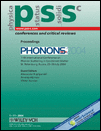Towards ultrafast pump-probe spectroscopy on trains of strain solitons
Abstract
We describe a low-repetition-rate ultrafast pump-probe setup, based on the picosecond ultrasonics technique, to be used to detect trains of strain solitons. The acoustic pulses are generated and probed with a kHz-amplified Ti:sapphire laser. By correcting on a pulse-to-pulse base, the sensitivity of the setup reaches 2 × 10–5 Hz1/2. We demonstrate the effectiveness of our setup by a series of pump-probe measurements on a thin chromium transducer at room temperature, and show that the injected strain in sapphire can exceed 2 × 10–3. A first measurement is presented on the arrival of a high-amplitude acoustic pulse that has travelled through a sapphire plate at room temperature, and qualitatively explained. This paves the way to detect high-amplitude individual solitons in the train at low temperatures with this pump-probe setup. (© 2004 WILEY-VCH Verlag GmbH & Co. KGaA, Weinheim)




